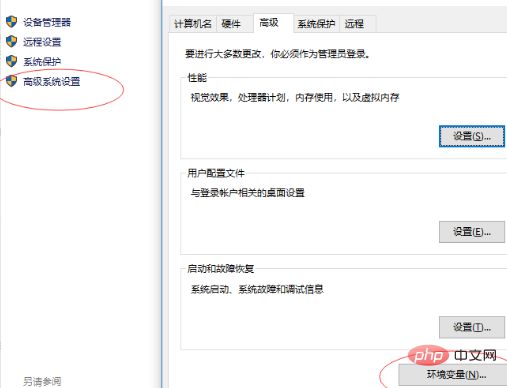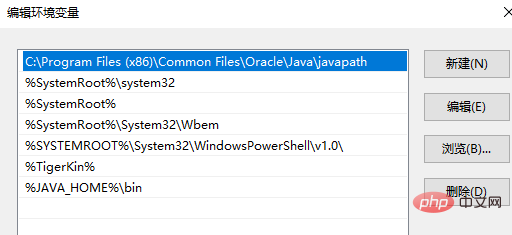Windows system configuration Java environment
Nov 12, 2019 am 10:31 AM
1. Right-click My Computer and select Properties

2. After entering, select Advanced System Settings, then select Environment Variables. After opening the environment variables dialog box, click the [New] button under [System Variables] below; then enter JAVA_HOME, and the corresponding variable value is the directory where your jdk is installed

3. Click OK. Then create a new variable name: classpath; variable value: .;%JAVA_HOME%\lib;%JAVA_HOME%\lib\tools.jar, click OK

4, and then enter the system variables Find the variable named "Path" and double-click it. The new variable is %JAVA_HOME%\bin

5. After confirmation, enter "java" and "java -version" respectively. "(java -version represents the version of java you installed) and javac. If they both run normally, it means that java has been installed correctly.
Recommended tutorial: Java tutorial
The above is the detailed content of Windows system configuration Java environment. For more information, please follow other related articles on the PHP Chinese website!

Hot AI Tools

Undress AI Tool
Undress images for free

Undresser.AI Undress
AI-powered app for creating realistic nude photos

AI Clothes Remover
Online AI tool for removing clothes from photos.

Clothoff.io
AI clothes remover

Video Face Swap
Swap faces in any video effortlessly with our completely free AI face swap tool!

Hot Article

Hot Tools

Notepad++7.3.1
Easy-to-use and free code editor

SublimeText3 Chinese version
Chinese version, very easy to use

Zend Studio 13.0.1
Powerful PHP integrated development environment

Dreamweaver CS6
Visual web development tools

SublimeText3 Mac version
God-level code editing software (SublimeText3)
 How to handle transactions in Java with JDBC?
Aug 02, 2025 pm 12:29 PM
How to handle transactions in Java with JDBC?
Aug 02, 2025 pm 12:29 PM
To correctly handle JDBC transactions, you must first turn off the automatic commit mode, then perform multiple operations, and finally commit or rollback according to the results; 1. Call conn.setAutoCommit(false) to start the transaction; 2. Execute multiple SQL operations, such as INSERT and UPDATE; 3. Call conn.commit() if all operations are successful, and call conn.rollback() if an exception occurs to ensure data consistency; at the same time, try-with-resources should be used to manage resources, properly handle exceptions and close connections to avoid connection leakage; in addition, it is recommended to use connection pools and set save points to achieve partial rollback, and keep transactions as short as possible to improve performance.
 How to reset the TCP/IP stack in Windows
Aug 02, 2025 pm 01:25 PM
How to reset the TCP/IP stack in Windows
Aug 02, 2025 pm 01:25 PM
ToresolvenetworkconnectivityissuesinWindows,resettheTCP/IPstackbyfirstopeningCommandPromptasAdministrator,thenrunningthecommandnetshintipreset,andfinallyrestartingyourcomputertoapplychanges;ifissuespersist,optionallyrunnetshwinsockresetandrebootagain
 How to troubleshoot a failed Windows installation
Aug 02, 2025 pm 12:53 PM
How to troubleshoot a failed Windows installation
Aug 02, 2025 pm 12:53 PM
VerifytheWindowsISOisfromMicrosoftandrecreatethebootableUSBusingtheMediaCreationToolorRufuswithcorrectsettings;2.Ensurehardwaremeetsrequirements,testRAMandstoragehealth,anddisconnectunnecessaryperipherals;3.ConfirmBIOS/UEFIsettingsmatchtheinstallatio
 How to configure Windows event forwarding
Aug 02, 2025 pm 03:48 PM
How to configure Windows event forwarding
Aug 02, 2025 pm 03:48 PM
ThekeytoconfiguringWindowsEventForwarding(WEF)issettinguptheEventCollectorandSourcescorrectlyusingbuilt-intools.2.First,enabletheWindowsEventCollectorserviceandconfigureWinRMonthecentralserver.3.Next,onclientmachines,useGroupPolicytoenableWinRMandset
 What are the main pros and cons of Linux vs. Windows?
Aug 03, 2025 am 02:56 AM
What are the main pros and cons of Linux vs. Windows?
Aug 03, 2025 am 02:56 AM
Linux is suitable for old hardware, has high security and is customizable, but has weak software compatibility; Windows software is rich and easy to use, but has high resource utilization. 1. In terms of performance, Linux is lightweight and efficient, suitable for old devices; Windows has high hardware requirements. 2. In terms of software, Windows has wider compatibility, especially professional tools and games; Linux needs to use tools to run some software. 3. In terms of security, Linux permission management is stricter and updates are convenient; although Windows is protected, it is still vulnerable to attacks. 4. In terms of difficulty of use, the Linux learning curve is steep; Windows operation is intuitive. Choose according to requirements: choose Linux with performance and security, and choose Windows with compatibility and ease of use.
 How to use volatile keyword in Java?
Aug 02, 2025 am 11:33 AM
How to use volatile keyword in Java?
Aug 02, 2025 am 11:33 AM
The volatile keyword is used to ensure that the read and write of variables occurs directly in main memory. 1. It ensures that variable modifications are immediately visible to all threads, and avoids threads reading expired values due to local cache; 2. It is suitable for scenarios such as flag bit control, double-check lock singletons, and ensures safe release of objects; 3. However, it does not guarantee the atomicity of composite operations. For example, AtomicInteger or synchronized is required for self-increase. Therefore, volatile is suitable for scenarios that require visibility but no atomicity, and cannot replace the synchronization mechanism. Its limitations must be clarified when using it.
 How to change screen resolution in Windows
Aug 02, 2025 pm 03:08 PM
How to change screen resolution in Windows
Aug 02, 2025 pm 03:08 PM
Right-clickthedesktopandselect"Displaysettings"toopenthedisplayoptions.2.Underthe"Display"section,clickthe"Displayresolution"dropdownandchoosearesolution,preferablytherecommendedoneforbestimagequality.3.Confirmthechanges
 How does garbage collection work in Java?
Aug 02, 2025 pm 01:55 PM
How does garbage collection work in Java?
Aug 02, 2025 pm 01:55 PM
Java's garbage collection (GC) is a mechanism that automatically manages memory, which reduces the risk of memory leakage by reclaiming unreachable objects. 1.GC judges the accessibility of the object from the root object (such as stack variables, active threads, static fields, etc.), and unreachable objects are marked as garbage. 2. Based on the mark-clearing algorithm, mark all reachable objects and clear unmarked objects. 3. Adopt a generational collection strategy: the new generation (Eden, S0, S1) frequently executes MinorGC; the elderly performs less but takes longer to perform MajorGC; Metaspace stores class metadata. 4. JVM provides a variety of GC devices: SerialGC is suitable for small applications; ParallelGC improves throughput; CMS reduces






